Solar Climate Features Taking into Account the Morphometric Conditions of the Area and the Possibility of Using Them in Heliotherapy on the Example of the Cieplice and Kołobrzeg Health Resorts (Poland)
Abstract
1. Introduction
2. Materials and Methods
2.1. Study Area
2.2. Materials
2.2.1. Heliographic and Actinometric Data
2.2.2. Digital Elevation Model
2.2.3. Corine Land Cover Database
2.3. Methods
2.3.1. Processing Heliographic and Actinometric Data
2.3.2. Calculation of Potential Incoming Solar Radiation
2.3.3. Maximum Entropy Model
3. Results
3.1. Analysis of Heliographic and Actinometric Data
3.1.1. Actual and Relative Sunshine Duration in Cieplice and Kołobrzeg in the Years 1996–2015
3.1.2. Global Solar Radiation in Cieplice and Kołobrzeg in the Years 1996–2015
3.2. Morphometric—Bioclimatic Analyses
3.2.1. Global Solar Radiation—SAGA Distribution
3.2.2. Maximum Entropy Model
4. Discussion
5. Conclusions
- Solar features of the climate of the research area, defined by the number of hours with the sun (sunshine duration), the sum of global solar radiation, and the height of the sun, indicate that the best conditions for heliotherapy are from April to September. The months from November to February are a particularly inadvisable period of the year when the unfavorable influence of astronomical factors for heliotherapy is combined with greater cloudiness.
- In late spring and summer, Kołobrzeg is a health resort with more favorable conditions for curative sunbathing, where less cloud cover and a longer day determine the occurrence of greater daily amounts of actual sunshine duration and global radiation than in Cieplice.
- The spatial distribution of global solar radiation, obtained with the use of remote sensing tools (SAGA), correlates with the actual actinometric measurements (Cieplice—0.929; Kołobrzeg—0.982). Micro- and macroscale morphometry, combined with the type of land cover (CLC), determines heliotherapy’s effectiveness.
- Topographic indicators that had a significant impact on heliotherapy’s effectiveness using the MaxEnt Model were AHM and SLP. The observed correlation, inversely proportional, stronger in the summer period, indicates that the increase in the intensity of the relief or the presence of high-exposure land cover and the season of the year affects the balance of solar radiation supply—thus the effectiveness of heliotherapy.
- The results of the MaxEnt Model showed that non-irrigated arable land (CLC type 2.1.1), pastures (2.3.1), and the sea zone (5.2.3)—in Kołobrzeg are the most favorable types of land cover in terms of heliotherapy. Considering the actual development of the areas mentioned above, only the last two seem to meet health treatment requirements. The percentage of the health resorts’ area favorable for heliotherapy (AUC > 0.50) was 49.8% for Cieplice and 33.8% for Kołobrzeg, respectively. This indicates that their area is right predisposed for the analyzed type of treatment. The least favorable type of land cover for heliotherapy is forests (CLC type 3.1.1–3.1.3), which are often used in health treatment because of their suitability to another climate therapy method, i.e., aerotherapy.
- The applied interdisciplinary research (bioclimatology and remote sensing) with the use of MaxEnt modeling makes it possible to determine the degree of heliotherapy effectiveness in already functioning health resorts and constitutes key elements in the future decision-making cycle to indicate future locations of such health resort. Our research shows the need to implement new research methods aimed at optimizing the organization of treatment based on environmental features influenced by climate change and anthropogenic pressure.
Author Contributions
Funding
Institutional Review Board Statement
Informed Consent Statement
Data Availability Statement
Acknowledgments
Conflicts of Interest
Appendix A
| Months | |||||||||||||
|---|---|---|---|---|---|---|---|---|---|---|---|---|---|
| I | II | III | IV | V | VI | VII | VIII | IX | X | XI | XII | ||
| Cieplice | |||||||||||||
| Min | kWh·m−2 | 21.56 | 30.86 | 62.28 | 101.04 | 93.43 | 125.64 | 109.91 | 101.91 | 60.69 | 40.97 | 22.17 | 15.05 |
| Max | 32.58 | 57.87 | 96.50 | 163.06 | 186.57 | 180.12 | 205.20 | 165.32 | 115.16 | 75.53 | 44.27 | 25.61 | |
| Av | 26.76 | 43.32 | 83.31 | 122.20 | 155.19 | 158.55 | 156.25 | 140.80 | 91.31 | 57.94 | 29.39 | 21.34 | |
| SD | 2.79 | 6.35 | 9.35 | 15.98 | 21.03 | 16.53 | 19.46 | 15.95 | 15.06 | 9.34 | 4.88 | 2.78 | |
| CV | % | 10.42 | 14.66 | 11.23 | 13.08 | 13.55 | 10.42 | 12.46 | 11.33 | 16.49 | 16.13 | 16.59 | 13.03 |
| Kołobrzeg | |||||||||||||
| Min | kWh·m−2 | 13.05 | 23.38 | 63.05 | 99.75 | 112.52 | 150.62 | 130.32 | 109.18 | 64.65 | 39.34 | 14.53 | 8.54 |
| Max | 21.60 | 40.14 | 90.99 | 158.41 | 211.12 | 196.67 | 211.72 | 169.36 | 108.21 | 65.13 | 25.76 | 13.72 | |
| Av | 16.28 | 31.57 | 76.73 | 122.51 | 165.34 | 171.67 | 164.47 | 137.54 | 92.80 | 49.22 | 19.18 | 10.96 | |
| SD | 2.28 | 4.64 | 8.20 | 15.62 | 21.15 | 14.32 | 21.38 | 15.17 | 9.89 | 6.07 | 2.63 | 1.32 | |
| CV | % | 14.02 | 14.68 | 10.68 | 12.75 | 12.79 | 8.34 | 13.00 | 11.03 | 10.66 | 12.34 | 13.73 | 12.04 |
| Months | |||||||||||||
|---|---|---|---|---|---|---|---|---|---|---|---|---|---|
| I | II | III | IV | V | VI | VII | VIII | IX | X | XI | XII | ||
| Cieplice | |||||||||||||
| Min | kWh·m−2 | 0.10 | 0.21 | 0.33 | 0.41 | 0.58 | 0.43 | 0.49 | 0.37 | 0.28 | 0.17 | 0.09 | 0.08 |
| Max | 2.19 | 3.66 | 5.65 | 7.34 | 8.33 | 9.01 | 8.61 | 8.96 | 5.83 | 4.12 | 2.96 | 1.79 | |
| Av | 0.86 | 1.55 | 2.69 | 4.07 | 5.01 | 5.28 | 5.04 | 4.54 | 3.04 | 1.87 | 0.98 | 0.69 | |
| A | − | 0.53 | 0.44 | 0.20 | −0.22 | −0.29 | −0.45 | −0.30 | −0.47 | −0.13 | 0.17 | 0.48 | 0.35 |
| CV | % | 54.81 | 52.77 | 49.76 | 43.15 | 40.40 | 38.02 | 38.13 | 35.51 | 46.18 | 50.35 | 56.22 | 55.10 |
| Kołobrzeg | |||||||||||||
| Min | kWh·m−2 | 0.07 | 0.14 | 0.14 | 0.13 | 0.58 | 0.60 | 0.41 | 0.60 | 0.42 | 0.16 | 0.08 | 0.05 |
| Max | 1.64 | 3.15 | 5.15 | 6.91 | 8.30 | 8.73 | 8.43 | 7.24 | 5.74 | 3.70 | 1.93 | 1.09 | |
| Av | 0.53 | 1.13 | 2.48 | 4.08 | 5.33 | 5.72 | 5.31 | 4.44 | 3.09 | 1.59 | 0.64 | 0.35 | |
| A | − | 0.92 | 0.62 | 0.12 | −0.36 | −0.58 | −0.54 | −0.45 | −0.39 | −0.13 | 0.36 | 0.91 | 0.97 |
| CV | % | 64.38 | 61.61 | 51.24 | 41.26 | 34.43 | 34.13 | 36.09 | 34.16 | 40.35 | 52.21 | 62.99 | 60.76 |
| CLC Type | Cieplice | Kołobrzeg | ||||||
|---|---|---|---|---|---|---|---|---|
| Cross-Validation | Bootstrap | Cross-Validation | Bootstrap | |||||
| Training | Test | Training | Test | Training | Test | Training | Test | |
| 1.1.2 | 0.703 | 0.702 | 0.713 | 0.709 | 0.677 | 0.676 | 0.687 | 0.683 |
| 1.2.3 | - | - | - | - | 0.865 | 0.851 | 0.873 | 0.868 |
| 1.2.4 | - | - | - | - | 0.822 | 0.818 | 0.829 | 0.821 |
| 1.4.2 | 0.848 | 0.841 | 0.856 | 0.849 | 0.847 | 0.841 | 0.853 | 0.850 |
| 2.1.1 | 0.634 | 0.633 | 0.645 | 0.644 | 0.831 | 0.828 | 0.839 | 0.840 |
| 2.3.1 | 0.794 | 0.789 | 0.800 | 0.793 | 0.699 | 0.698 | 0.710 | 0.711 |
| 2.4.2 | 0.769 | 0.765 | 0.774 | 0.771 | 0.896 | 0.873 | 0.918 | 0.870 |
| 2.4.3 | 0.824 | 0.822 | 0.831 | 0.823 | - | - | - | - |
| 3.1.1 | - | - | - | - | 0.831 | 0.830 | 0.841 | 0.840 |
| 3.1.2 | - | - | - | - | 0.914 | 0.891 | 0.928 | 0.901 |
| 3.1.3 | 0.839 | 0.835 | 0.843 | 0.839 | 0.885 | 0.882 | 0.893 | 0.890 |
| 5.1.2 | 0.892 | 0.845 | 0.911 | 0.843 | - | - | - | - |
| 5.3.2 | - | - | - | - | 0.888 | 0.875 | 0.897 | 0.887 |
References
- Gest, H. Bicentenary homage to Dr Jan Ingen-Housz, MD (1730–1799), pioneer of photosynthesis research. Photosynth. Res. 2000, 63, 183–190. [Google Scholar] [CrossRef]
- Zhang, J.; Zhao, L.; Deng, S.; Xu, W.; Zhang, Y. A critical review of the models used to estimate solar radiation. Renew. Sustain. Energy Rev. 2017, 70, 314–329. [Google Scholar] [CrossRef]
- Niedźwiedź, T. Słownik Meteorologiczny; Polskie Towarzystwo Geofizyczne, Instytut Meteorologii i Gospodarki Wodnej: Warsaw, Poland, 2003; p. 495. [Google Scholar]
- Lam, J.C.; Li, D.H.W. Correlation between global solar radiation and its direct and diffuse components. Build. Environ. 1996, 31, 527–535. [Google Scholar] [CrossRef]
- Wild, M. Global dimming and brightening: A review. J. Geophys. Res. 2009, 114, D00D16. [Google Scholar] [CrossRef]
- Roupioz, L.; Jia, L.; Nerry, F.; Menenti, M. Estimation of daily solar radiation budget at kilometer resolution over the Tibetan Plateau by integrating MODIS data products and a DEM. Remote Sens. 2016, 8, 504. [Google Scholar] [CrossRef]
- Campbell, G.S.; Norman, J.M. Radiation Basics an Introduction to Environmental Biophysics; Springer: New York, NY, USA, 1998; pp. 147–165. [Google Scholar]
- Liu, J.; Linderholm, H.; Chen, D.; Zhou, X.; Flerchinger, G.N.; Yu, Q.; Wu, D.; Shen, Y.; Yang, Z. Changes in the relationship between solar radiation and sunshine duration in large cities of China. Energy 2015, 82, 589–600. [Google Scholar] [CrossRef]
- Koronakis, P.S.; Sfantos, G.K.; Paliatsos, A.G.; Kaldellis, J.K.; Garofalakis, J.E.; Koronaki, I.P. Interrelations of UV-global/global/diffuse solar irradiance components and UV-global attenuation on air pollution episode days in Athens, Greece. Atmos. Environ. 2002, 36, 3173–3181. [Google Scholar] [CrossRef]
- Zhao, N.; Zeng, X.; Han, S. Solar radiation estimation using sunshine hour and air pollution index in China. Energy Convers. Manag. 2013, 76, 846–851. [Google Scholar] [CrossRef]
- WMO. Guide to Instruments and Methods of Observation. Measurement of Meteorological Variables; World Meteorological Organization (WMO): Geneva, Switzerland, 2018; Volume 1, p. 573. [Google Scholar]
- Woś, A. Klimat Polski w Drugiej Połowie XX Wieku; Wydawnictwo Naukowe UAM: Poznan, Poland, 2010; p. 489. [Google Scholar]
- Błażejczyk, K.; Kunert, A. Bioklimatyczne Uwarunkowania Rekreacji i Turystyki w Polsce, 2nd ed.; PAN IGiPZ: Warsaw, Poland, 2011; p. 370. [Google Scholar]
- Matuszko, D.; Bartoszek, K.; Soroka, J.; Węglarczyk, S. Zmienność i zróżnicowanie usłonecznienia w Polsce w latach 1917–2018, na podstawie danych naziemnych i satelitarnych. In Współczesne Problemy Klimatologii Polski; Chojnacka-Ożga, L., Lorenc, H., Eds.; Instytut Meteorologii i Gospodarki Wodnej, Państwowy Instytut Badawczy: Warsaw, Poland, 2019; pp. 53–66. [Google Scholar]
- Lucas, R.; McMichael, T.; Smith, W.; Armstrong, B. Solar Ultraviolet Radiation. In Global Burden of Disease from Solar Ultraviolet Radiation; Environmental Burden of Disease Series; WHO, Public Health and the Environment: Geneva, Switzerland, 2006; p. 258. [Google Scholar]
- World Health Organization; World Meteorological Organization; United Nations Environment Programme; International Commission on Non-Ionizing Radiation Protection. Global Solar UV Index: A Practical Guide; World Health Organization: Geneva, Switzerland, 2002; p. 28. [Google Scholar]
- Podstawczyńska, A. Cechy solarne klimatu Łodzi. Acta Univ. Lodz. Folia Geogr. Phys. 2007, 7, 294. [Google Scholar]
- Kozłowska-Szczęsna, T.; Błażejczyk, K.; Krawczyk, B. Bioklimatologia Człowieka. Metody i ich Zastosowania w Badaniach Bioklimatu Polski; Monografie IGiPZ PAN: Warsaw, Poland, 1997; p. 202. [Google Scholar]
- Kmieć, P.; Sworczak, K. Korzyści i zagrożenia wynikające z suplementacji witaminą D. Forum Med. Rodz. 2017, 11, 38–46. [Google Scholar]
- Czerwińska, A.E.; Krzyścin, J.W. Analysis of Measurements and Modelling of the Biologically Active UV Solar Radiation for Selected Sites in Poland—Assessment of Photo-Medical Effects; Polska Akademia Nauk, Instytut Geofizyki: Warsaw, Poland, 2020; p. 116. [Google Scholar]
- Sieniawska, J.; Lesiak, A.; Segerbäck, D.; Young, A.R.; Woźniacka, A.; Narbutt, J. Wakacyjna ekspozycja na słońce zwiększa stężenie witaminy D oraz dimerów tymidynowych u dzieci przebywających na obozie. Forum Dermatol. 2016, 2, 73–80. [Google Scholar]
- Błażejczyk, K.; Błażejczyk, A. Changes in UV radiation intensity and their possible impact on skin cancer in Poland. Geogr. Pol. 2012, 85, 57–64. [Google Scholar] [CrossRef]
- Fitzpatrick, T.B. The validity and practicality of sun-reactive skin type I through VI. Arch. Dermatol. 1988, 124, 869–871. [Google Scholar] [CrossRef]
- Matos, T.R.; Ling, T.C.; Sheth, V. Ultraviolet B radiation therapy for psoriasis: Pursuing the optimal regime. Clin. Dermatol. 2016, 34, 587–593. [Google Scholar] [CrossRef] [PubMed]
- Kozłowska-Szczęsna, T.; Krawczyk, B.; Kuchcik, M. Wpływ Środowiska Atmosferycznego na Zdrowie i Samopoczucie Człowieka; IG&SO Polish Academy of Sciences: Warsaw, Poland, 2004; p. 198. [Google Scholar]
- Kasprzak, W.; Mańkowska, A. Fizykoterapia, Medycyna Uzdrowiskowa i SPA; Wydawnictwo Lekarskie PZWL: Warsaw, Poland, 2009; p. 604. [Google Scholar]
- Hartung, J. Ultraviolet therapy at the North Sea coast. In The Biologic Effects of Ultraviolet Radiation; Urbach, F., Ed.; Pergamon Press: Oxford, UK, 1969; pp. 657–661. [Google Scholar]
- Hobday, R.A. Sunlight therapy and solar architecture. Med. Hist. 1997, 41, 455–472. [Google Scholar] [CrossRef]
- Boreham, D.R.; Gasmann, H.C.; Mitchel, R.E. Water bath hyperthermia is a simple therapy for psoriasis and also stimulates skin tanning in response to sunlight. Int. J. Hyperth. 1995, 11, 745–754. [Google Scholar] [CrossRef] [PubMed]
- Alora, M.B.T.; Fitzpatrick, T.B.; Taylor, C.R. Total body heliotherapy. Photodermatol. Photoimmunol. Photomed. 1997, 13, 178–180. [Google Scholar] [CrossRef]
- Kushelevsky, A.P.; Harari, M.; Kudish, A.I.; Hristakieva, E.; Ingber, A.; Shani, J. Safety of solar phototherapy at the Dead Sea. J. Am. Acad. Dermatol. 1998, 38, 447–452. [Google Scholar] [CrossRef]
- Snellman, E.; Maljanen, T.; Aromaa, A.; Reunanen, A.; Jyrkinen-Pakkasvirta, T.; JLuoma, J. Effect of heliotherapy on the cost of psoriasis. Br. J. Dermatol. 1998, 138, 288–292. [Google Scholar] [CrossRef] [PubMed]
- Cohen, A.D.; Shapiro, J.; Michael, D.; Hodak, E.; Van-Dijk, D.; Naggan, L.; Vardy, D.A. Out-come of “short-term” Dead Sea climatotherapy for psoriasis. Acta Derm. Venereol. 2008, 88, 90–91. [Google Scholar] [CrossRef][Green Version]
- Kazandjieva, J.; Grozdev, I.; Darlenski, R.; Tsankov, N. Climatotherapy of psoriasis. Clin. Dermatol. 2008, 26, 477–485. [Google Scholar] [CrossRef]
- Karppinen, T.; Ylianttila, L.; Kautiainen, H.; Reunala, T.; Snellman, E. Empowering heliotherapy improves clinical outcome and quality of life of psoriasis and atopic dermatitis patients. Acta Derm. Venereol. 2015, 95, 579–582. [Google Scholar] [CrossRef] [PubMed]
- Krzyścin, J.W.; Narbutt, J.; Lesiak, A.; Jarosławski, J.; Sobolewski, P.S.; Rajewska-Więch, B.; Szkop, A.; Wink, J.; Czerwińska, A. Perspectives of the antipsoriatic heliotherapy in Poland. J. Photochem. Photobiol. B Biol. 2014, 140, 111–119. [Google Scholar] [CrossRef] [PubMed]
- Krzyścin, J.W.; Guzikowski, J.; Czerwińska, A.; Lesiak, A.; Narbutt, J.; Jarosławski, J.; Sobolewski, P.S.; Rajewska-Więch, B.; Wink, J. 24 hour forecast of the surface UV for the antipsoriatic heliotherapy in Poland. J. Photochem. Photobiol. B Biol. 2015, 148, 136–144. [Google Scholar] [CrossRef]
- Bowszyc-Dmochowska, M. Fototerapia w dermatologii. Przew. Lek. 2006, 7, 85–91. [Google Scholar]
- Vähävihu, K.; Ylianttila, L.; Salmelin, R.; Lamberg-Allardt, C.; Viljakainen, H.; Tuohimaa, P.; Reunala, T.; Snellman, E. Heliotherapy improves vitamin D balance and atopic dermatitis. Br. J. Dermatol. 2008, 158, 1323–1328. [Google Scholar] [CrossRef]
- Kudish, A.; Marsakova, A.; Jahn, I.; Gkalpakiotis, S.; Arenberger, P.; Harari, M. Dead Sea ultraviolet climatotherapy for children with atopic dermatitis. Photodermatol. Photoimmunol. Photomed. 2016, 32, 254–261. [Google Scholar] [CrossRef] [PubMed]
- Kuchcik, M.; Błażejczyk, K.; Szmyd, J.; Milewski, P.; Błażejczyk, A.; Baranowski, J. Potencjał Leczniczy Klimatu Polski; Wydawnictwo Akademickie SEDNO, Instytut Geografii i Przestrzennego Zagospodarowania PAN: Warsaw, Poland, 2013; p. 272. [Google Scholar]
- Holick, M.F. Vitamin D deficiency. N. Engl. J. Med. 2007, 357, 266–281. [Google Scholar] [CrossRef]
- Baggerly, C.A.; Cuomo, R.E.; French, C.B.; Garland, C.F.; Gorham, E.D.; Grant, W.B.; Heaney, R.P.; Holick, M.F.; Hollis, B.W.; McDonnell, S.L.; et al. Sunlight and vitamin D: Necessary for public health. J. Am. Coll. Nutr. 2015, 34, 359–365. [Google Scholar] [CrossRef]
- Kuczmarski, M. Usłonecznienie Polski i jego przydatność dla helioterapii. Dok. Geogr. 1990, 4, 67. [Google Scholar]
- Matzarakis, A.; Rutz, F.; Mayer, H. Modelling radiation fluxes in simple and complex environments: Basics of the RayMan model. Int. J. Biometeorol. 2010, 54, 131–139. [Google Scholar] [CrossRef]
- Krüger, E.L.; Minella, F.O.; Rasia, F. Impact of urban geometry on outdoor thermal comfort and air quality from field measurements in Curitiba, Brazil. Build. Environ. 2011, 46, 621–634. [Google Scholar] [CrossRef]
- Perini, K.; Magliocco, A. Effects of Vegetation, Urban Density, Building Height, and Atmospheric Conditions on Local Temperatures and Thermal Comfort. Urban For. Urban Green. 2014, 13, 495–506. [Google Scholar] [CrossRef]
- Cetin, M.; Adiguzel, F.; Kaya, O.; Sahap, A. Mapping of bioclimatic comfort for potential planning using GIS in Aydin. Environ. Dev. Sustain. 2018, 20, 361–375. [Google Scholar] [CrossRef]
- Roth, M.; Oke, T.R.; Emery, W.J. Satellite-derived urban heat island from three coastal cities and the utilization of such data in urban climatology. Int. J. Remote Sens. 1989, 10, 1699–1720. [Google Scholar] [CrossRef]
- Matzarakis, A.; Matuschek, O. Sky view factor as a parameter in applied climatology—Rapid estimation by the SkyHelios model. Meteorol. Z. 2011, 20, 39–45. [Google Scholar] [CrossRef]
- Eliasson, I. Infrared thermography and urban temperature patterns. Int. J. Remote Sens. 1992, 13, 869–879. [Google Scholar] [CrossRef]
- Parlow, E. Remotely-sensed heat fluxes of urban areas. In Biometeorologzy and Urban Climatology at the Turn of the Millennium; de Dear, R.J., Kalma, J.D., Oke, T.R., Auliciems, A., Eds.; World Meteorological Organization Tech. Doc.: Geneva, Switzerland, 1999; Volume 1026, pp. 523–528. [Google Scholar]
- Voogt, J.A.; Grimmond, C.S.B. Modeling surface sensible heat flux using surface radiative temperatures in a simple urban area. J. Appl. Meteorol. 2000, 39, 1679–1699. [Google Scholar] [CrossRef]
- Montero-Martín, J.; Antón, M.; Vaquero-Martínez, J.; Sanchez-Lorenzo, A. Comparison of long-term solar radiation trends from CM SAF satellite products with ground-based data at the Iberian Peninsula for the period 1985–2015. Atmos. Res. 2020, 236, 104839. [Google Scholar] [CrossRef]
- Lindfors, A.V.; Hertsberg, A.; Riihelä, A.; Carlund, T.; Trentmann, J.; Müller, R. On the Land-Sea Contrast in the Surface Solar Radiation (SSR) in the Baltic Region. Remote Sens. 2020, 12, 3509. [Google Scholar] [CrossRef]
- Kulesza, K. Spatiotemporal variability and trends in global solar radiation over Poland based on satellite-derived data 1986–2015. Int. J. Climatol. 2020, 40, 6526–6543. [Google Scholar] [CrossRef]
- Dryglas, D. Kształtowanie Produktu Turystycznego Uzdrowisk w Polsce; Wydawnictwo Uniwersytetu Jagiellońskiego: Krakow, Poland, 2006; pp. 63–65. [Google Scholar]
- Golba, J.; Rymarczyk-Wajda, K. (Eds.) Europejskie Ustawy Uzdrowiskowe; Stowarzyszenie Gmin Uzdrowiskowych RP: Krynica-Zdrój, Poland, 2008. [Google Scholar]
- Golba, J. Stan prawny uzdrowisk polskich w porównaniu ze stanem prawnym uzdrowisk w krajach Unii Europejskiej - wyzwania, jakie stoją przed Rządem i środowiskiem uzdrowiskowym. Biul. Inf. SGU RP 2003, 2–3, 16. [Google Scholar]
- Ustawa z Dnia 28 lipca 2005 r. o Lecznictwie Uzdrowiskowym, Uzdrowiskach i Obszarach Ochrony Uzdrowiskowej Oraz o Gminach Uzdrowiskowych, Dz.U. 2005, Nr 167, Poz. 1399. Available online: isap.sejm.gov.pl (accessed on 14 December 2020).
- Rozporządzenie Ministra Zdrowia z Dnia 13 Kwietnia 2006 r. w Sprawie Zakresu Badań Niezbędnych do Ustalenia Właściwości Leczniczych Naturalnych Surowców Leczniczych i Właściwości Leczniczych Klimatu, Kryteriów ich Oceny Oraz Wzoru Świadectwa Potwierdzającego te Właściwości, Dz.U. 2006, Nr 80, poz. 565. Available online: isap.sejm.gov.pl (accessed on 14 December 2020).
- Kulesza, K. Wpływ Cyrkulacji Atmosferycznej na ilość Promieniowania Słonecznego Docierającego do Powierzchni Ziemi w Polsce. Ph.D. Thesis, Warsaw University, Warsaw, Poland, 2019. [Google Scholar]
- Boehner, J.; Antonić, O. Land Surface Parameters Specific to Topo-Climatology. In Geomorphometry—Concepts, Software, Applications; Hengl, T., Reuter, H.I., Eds.; Elsevier Science: Amsterdam, The Netherlands, 2009; Volume 33, pp. 195–226. [Google Scholar]
- Ustawa z Dnia 20lipca 2017 r.—Prawo Wodne, Dz.U. 2017, Poz. 1566. Available online: isap.sejm.gov.pl (accessed on 14 December 2020).
- The Weather Station Employee; (The Institute of Meteorology and Water Management—National Research Institute, Kołobrzeg-Dźwirzyno, Poland). Personal communication, 2021.
- Barbero, F.J.; López, G.; Batlles, F.J. Determination of daily solar ultraviolet radiation using statistical models and artificial neural networks. Ann. Geophys. 2006, 24, 2105–2114. [Google Scholar] [CrossRef]
- Bilbao, J.; Miguel, A. Estimation of UV-B irradiation from total global solar meteorological data in central Spain. J. Geophys. Res. 2010, 115, D00I09. [Google Scholar] [CrossRef]
- Habte, A.; Sengupta, M.; Gueymard, C.A.; Narasappa, R.; Rosseler, O.; Burns, D.M. Estimating Ultraviolet Radiation From Global Horizontal Irradiance. IEEE J. Photovolt. 2018, 99, 1–8. [Google Scholar] [CrossRef]
- Feranec, J.; Hazeu, G.; Christensen, S.; Jaffrain, G. Corine land cover change detection in Europe (case studies of the Netherlands and Slovakia). Land Use Policy 2007, 24, 234–247. [Google Scholar] [CrossRef]
- Kalagirou, S.A. Solar Energy Engineering. Processes and Systems, 2nd ed.; Elsevier: Oxford, UK, 2014; p. 819. [Google Scholar]
- Uchwała Nr 260.XXVIII.2012 Rady Miejskiej Jeleniej Góry z dnia 9 lipca 2012 r.w Sprawie Nadania Statutu Uzdrowiska Cieplice. Available online: www.bip.um-jeleniagora.dolnyslask.pl (accessed on 14 December 2020).
- Uchwała Nr XL/526/13 Rady Miasta Kołobrzeg z dnia 26 listopada 2013 r.w sprawie uchwalenia Statutu Uzdrowiska Kołobrzeg D.U. Woj. Zachodniopomorskiego Nr 4481 z dnia 13 grudnia 2013. Available online: e-dziennik.szczecin.uw.gov.pl (accessed on 14 December 2020).
- Heymann, Y.; Steenmans, C.; Croisille, G.; Bossard, M. CORINE Land Cover. Technical Guide; Office for Official Publications of the European Communities: Luxembourg, 1994; p. 136. [Google Scholar]
- Phillips, S.J.; Anderson, R.P.; Schapire, R.E. Maximum entropy modeling of species geographic distributions. Ecol. Model. 2006, 190, 231–259. [Google Scholar] [CrossRef]
- Phillips, S.J.; Dudik, M. Modeling of species distributions with Maxent: New extensions and a comprehensive evaluation. Ecography 2008, 31, 161–175. [Google Scholar] [CrossRef]
- Saatchi, S.; Buermann, W.; Steege, H.; Mori, S.; Smith, T.B. Modeling distribution of Amazonian tree species and diversity using remote sensing measurements. Remote Sens. Environ. 2008, 112, 2000–2017. [Google Scholar] [CrossRef]
- Bosino, A.; Giordani, P.; Queneherve, G.; Maerker, M. Assessment of calanchi and rill-interrill erosion susceptibilities using terrain analysis and geostochastics: A case study in the Oltrepo Pavese, Northern Apennines, Italy. Earth Surf. Process. Landf. 2020, 45, 3025–3041. [Google Scholar] [CrossRef]
- Tarini, M.; Cignoni, P.; Montani, C. Ambient Occlusion and Edge Cueing to Enhance Real Time Molecular Visualization. IEEE Trans. Vis. Comput. Graph. 2006, 12, 1237–1244. [Google Scholar] [CrossRef] [PubMed]
- Zevenbergen, L.W.; Thorne, C.R. Quantitative analysis of land surface topography. Earth Surf. Process. Landf. 1987, 12, 47–56. [Google Scholar] [CrossRef]
- Koethe, R.; Lehmeier, F. SARA—System zur Automatischen Relief-Analyse. User Manual, 2nd ed.; unpublished.
- Phillips, S.J.; Dudík, M.; Elith, J.; Graham, C.H.; Lehmann, A.; Leathwick, J.; Ferrier, S. Sample selection bias and presence-only distribution models: Implications for background and pseudo-absence data. Ecol. Appl. 2009, 19, 181–197. [Google Scholar] [CrossRef] [PubMed]
- Fielding, A.H.; Bell, J.F. A Review of Methods for the Assessment of Prediction Errors in Conservation Presence/Absence Models. Environ. Conserv. 1997, 24, 38–49. [Google Scholar] [CrossRef]
- Hosmer, D.W.; Lemeshow, S. Applied Logistic Regression, 3rd ed.; Wiley: New York, NY, USA, 2000; p. 528. [Google Scholar]
- Sanchez-Lorenzo, A.; Brunetti, M.; Calbo, J.; Martin-Vide, J. Recent spatial and temporal variability and trends of sunshine duration over the Iberian Peninsula from a homogenized data set. J. Geophys. Res. 2007, 112, D20115. [Google Scholar] [CrossRef]
- Matuszko, D. Usłonecznienie w miastach na przykładzie wybranych stacji w Europie. Acta Geogr. Lodz. 2016, 104, 45–56. [Google Scholar]
- Matuszko, D.; Celiński-Mysław, D.; Soroka, J. Usłonecznienie w Arktyce Europejskiej i Grenlandii na podstawie danych z wybranych stacji strefy polarnej. Probl. Klimatol. Polarn. 2015, 25, 127–138. [Google Scholar]
- Żmudzka, E. Wybrane cechy zmienności zachmurzenia nad Polską. Pr. Studia Geogr. 2014, 56, 231–249. [Google Scholar]
- Sypniewska, L.; Szyga-Pluta, K. Zmienność czasowa i zróżnicowanie przestrzenne zachmurzenia w Polsce w latach 2001–2016. Bad. Fizjogr. 2018, IX, 193–213. [Google Scholar]
- Krzyścin, J.W.; Jarosławski, J.; Rajewska-Więch, B.; Sobolewski, P.S.; Narbutt, J.; Lesiak, A.; Pawlaczyk, M. Effectiveness of heliotherapy for psoriasis clearance in low and mid-latitudinal regions: A theoretical approach. J. Photochem. Photobiol. B Bio. 2012, 115, 35–41. [Google Scholar] [CrossRef] [PubMed]
- Harańczyk, A. Przemiany w użytkowaniu gruntów w miastach wojewódzkich w latach 2010 i 2014. Studia Miej. 2015, 18, 131–146. [Google Scholar]
- Rudewicz, J. Zmiany kierunków użytkowania gruntów ze szczególnym uwzględnieniem terenów przemysłowych w wielkich miastach Polski i ich otoczeniu w latach 2005 i 2009–2014. Prace Kom. Geogr. Przem. Pol. Tow. Geogr. 2016, 30, 122–141. [Google Scholar]
- Voogt, J.A.; Oke, T.R. Thermal remote sensing of urban climates. Remote Sens. Environ. 2003, 86, 370–384. [Google Scholar] [CrossRef]
- Ali-Toudert, F.; Mayer, H. Effects of asymmetry, galleries, overhanging façades and vegetation on thermal comfort in urban street canyons. Solar Enger. 2007, 81, 742–754. [Google Scholar] [CrossRef]
- Mills, G. The radiative effects of building groups on single structures. Energy Build. 1997, 25, 51–61. [Google Scholar] [CrossRef]
- Arnfield, A.J. Two decades of urban climate research: A review of turbulence, exchanges of energy and water, and the urban heat island. Int. J. Climatol. 2003, 23, 1–26. [Google Scholar] [CrossRef]
- Bärring, L.; Mattsson, J.O.; Lindqvist, S. Canyon geometry, street temperatures and urban heat island in malmö, sweden. J. Climatol. 1985, 5, 433–444. [Google Scholar] [CrossRef]
- Bridgman, H.; Warner, R.; Dodson, J. Urban Biophysical Environment; Oxford University Press: Oxford, UK, 1995; p. 152. [Google Scholar]
- Thorsson, S.; Lindqvist, M.; Lindqvist, S. Thermal bioclimatic conditions and patterns of behaviour in an urban park in Göteborg, Sweden. Int. J. Biometeorol. 2004, 48, 149–156. [Google Scholar] [CrossRef]
- Zeren-Cetin, I.; Sevik, H. Investigation of the relationship between bioclimatic comfort and land use by using GIS and RS techniques in Trabzon. Environ. Monit. Assess. 2020, 192, 71. [Google Scholar] [CrossRef]
- Schuh, A. Climatotherapy. Experientia 1993, 49, 947–956. [Google Scholar] [CrossRef]
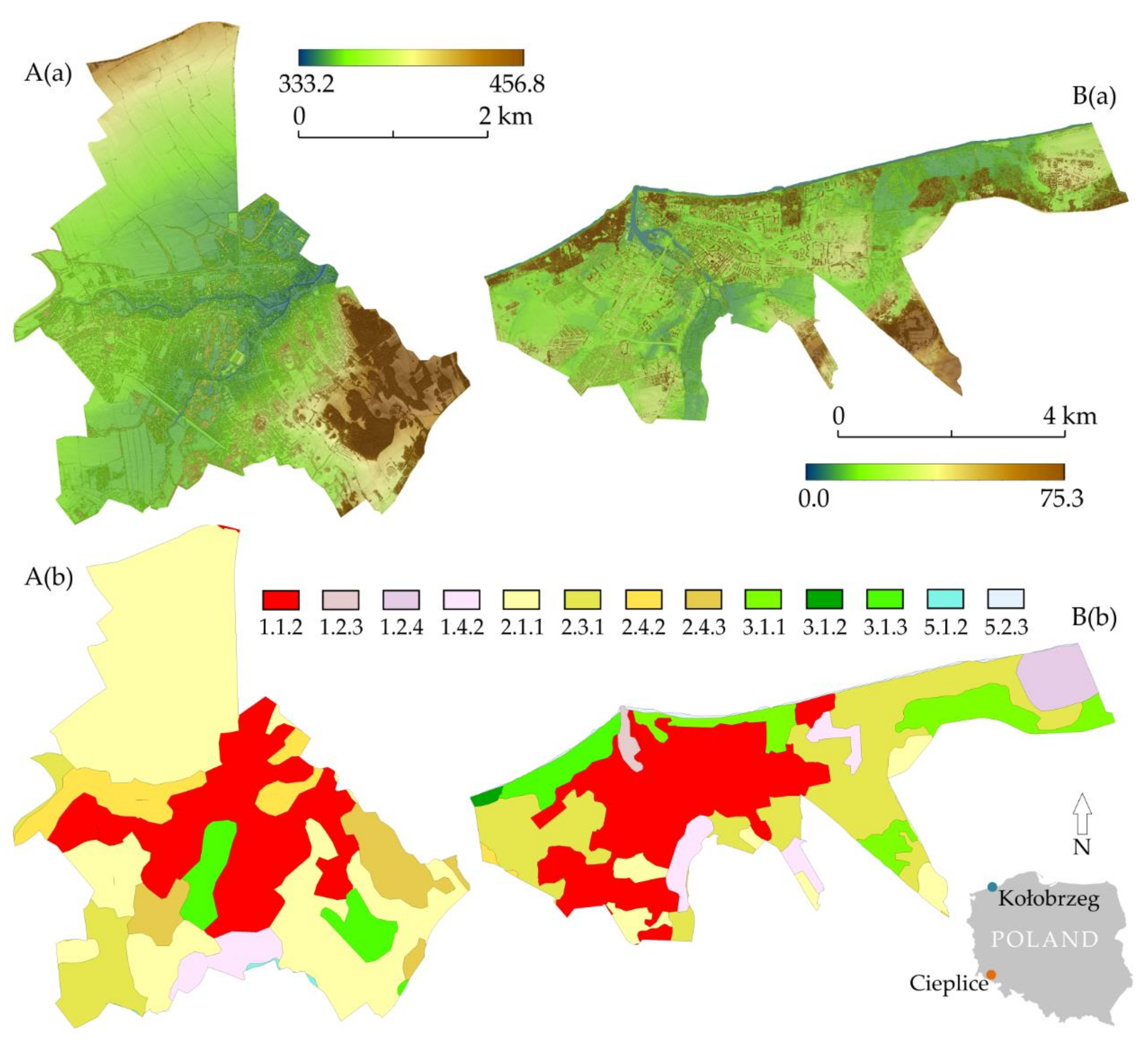
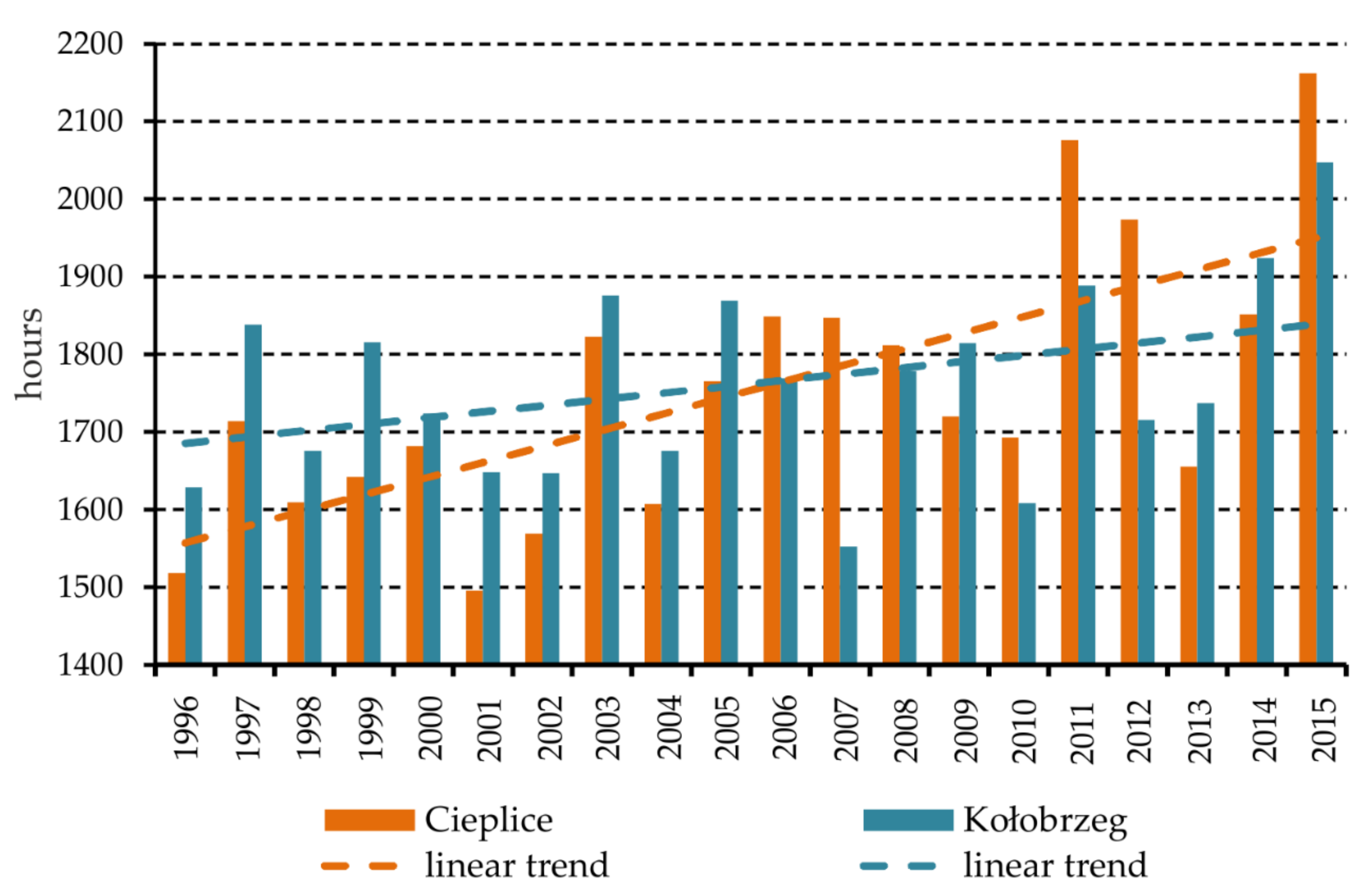
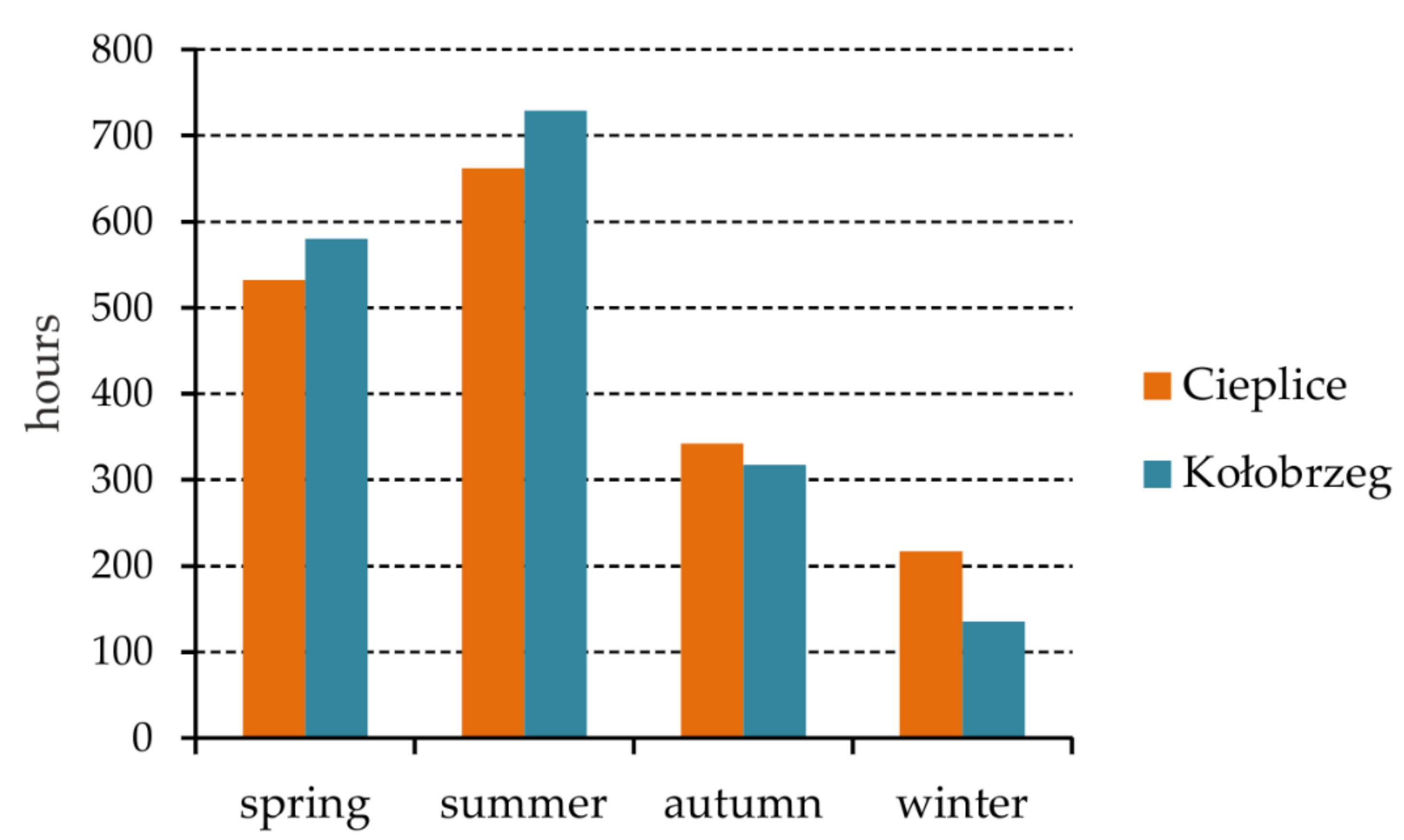
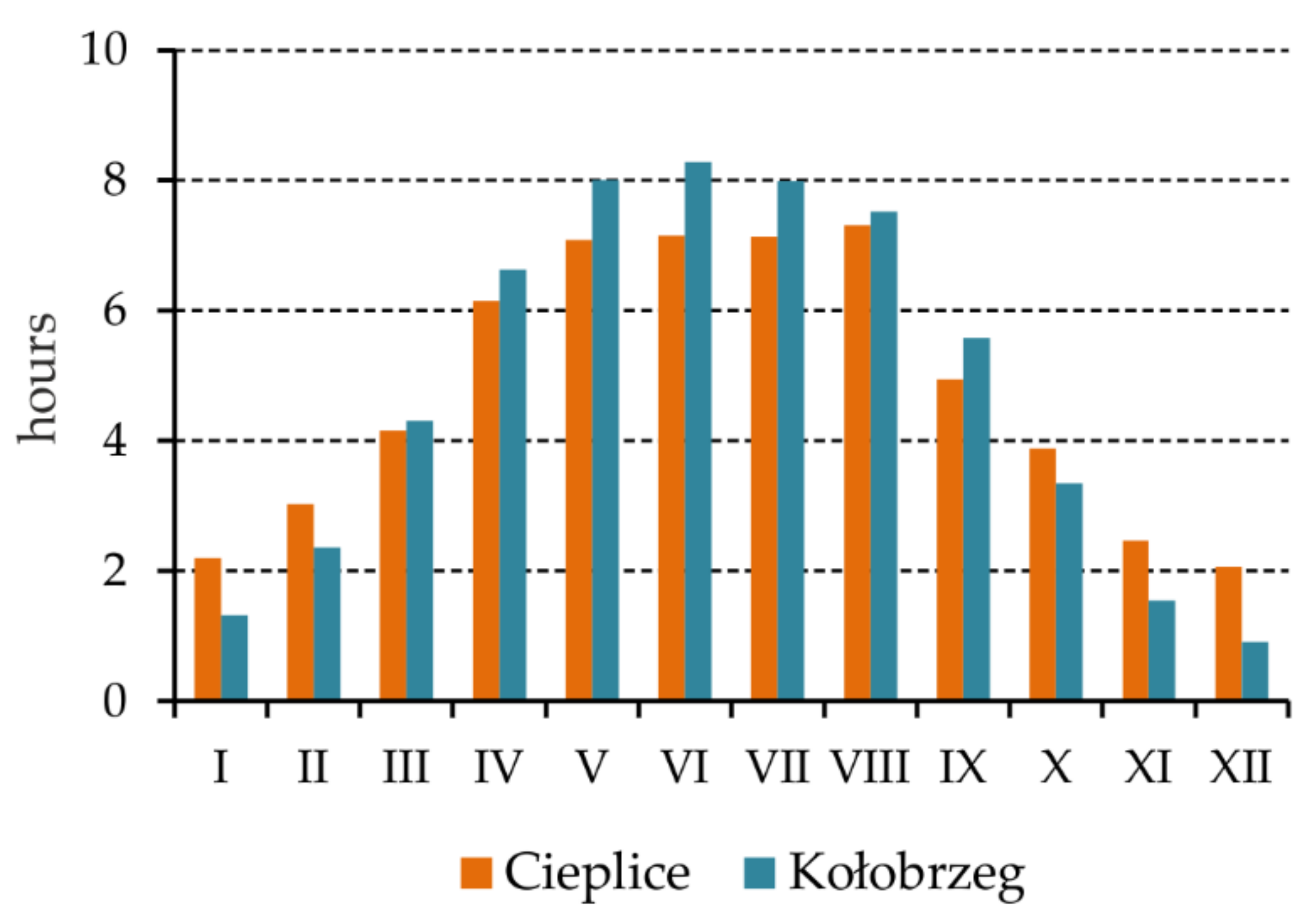
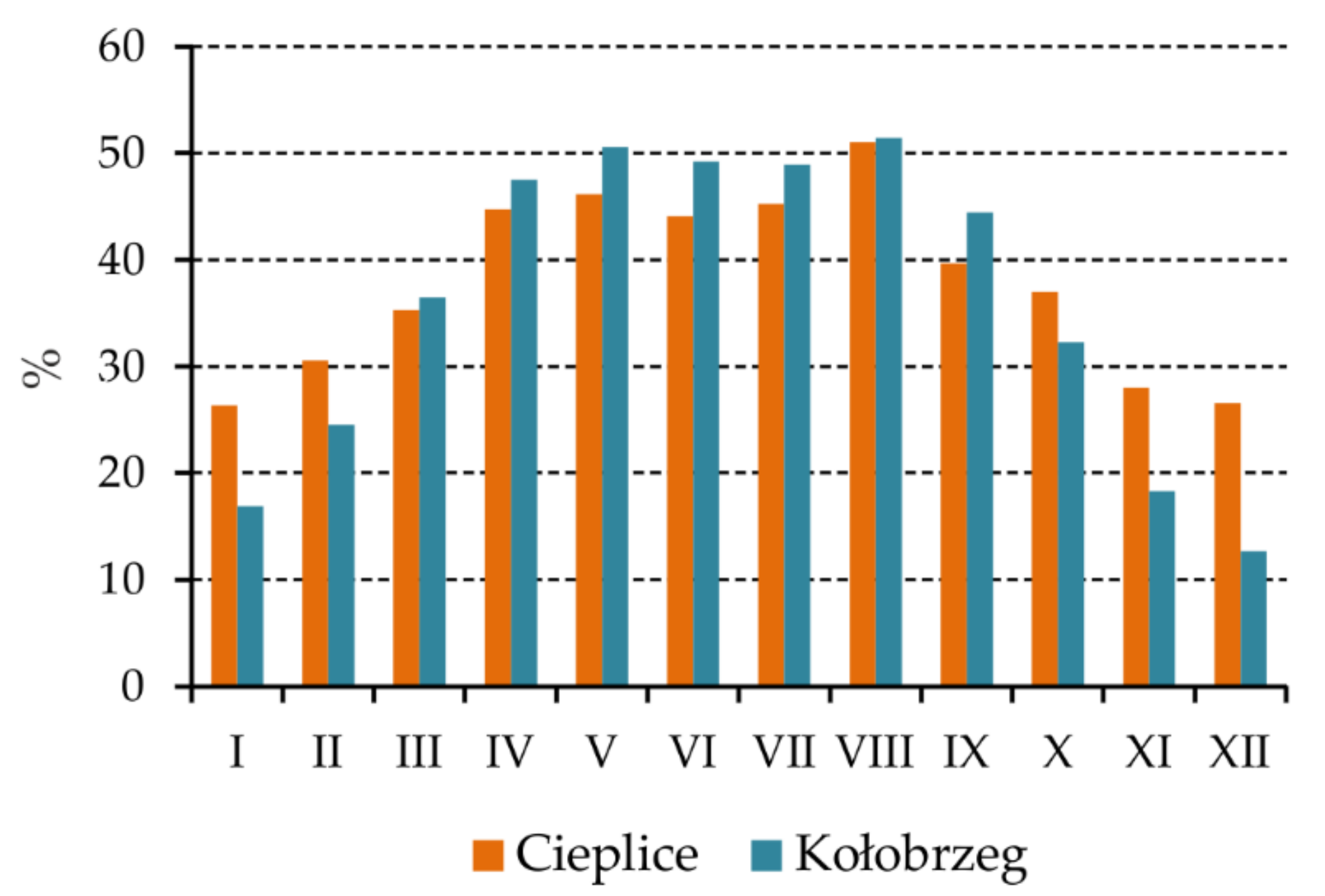
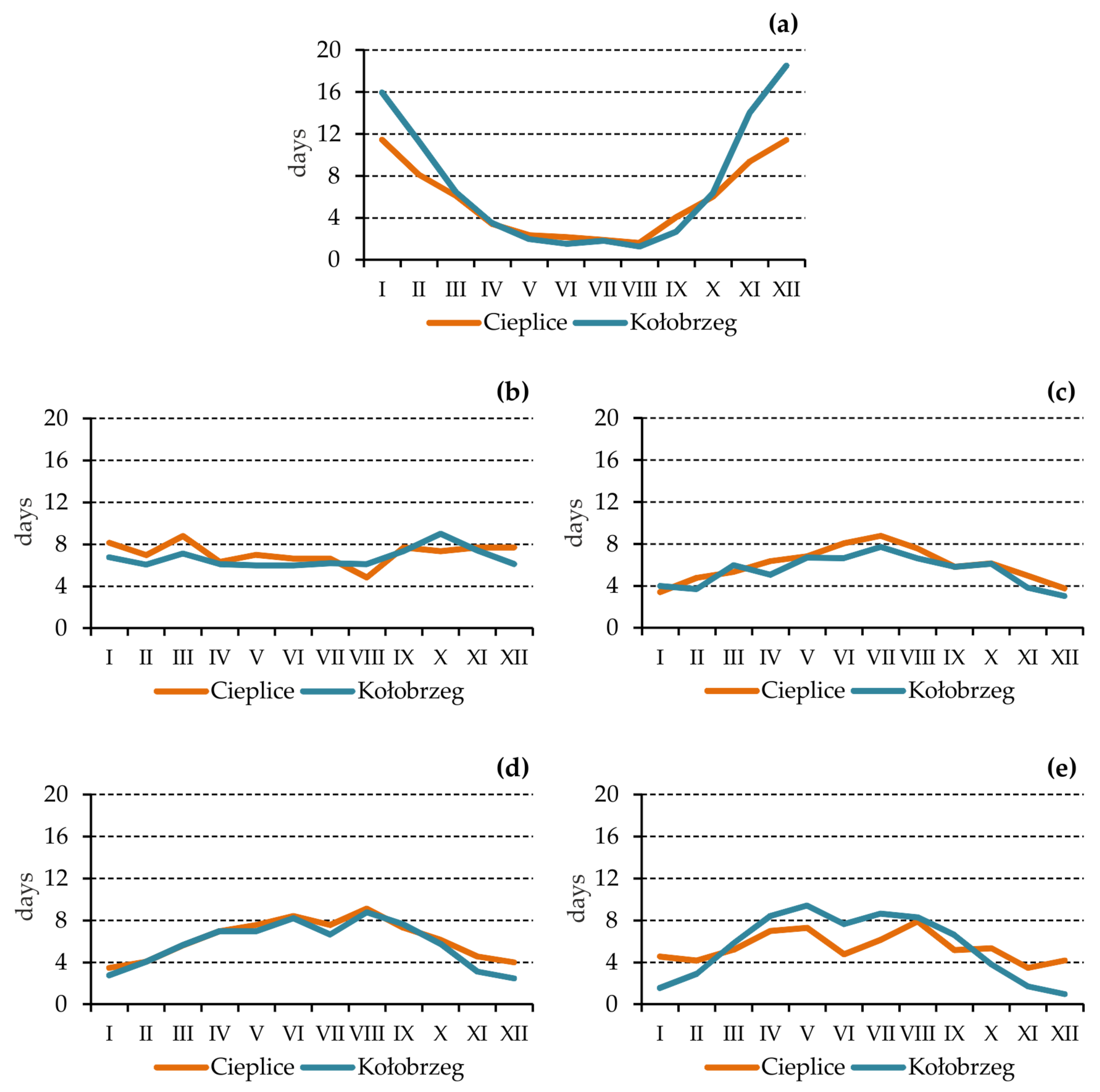
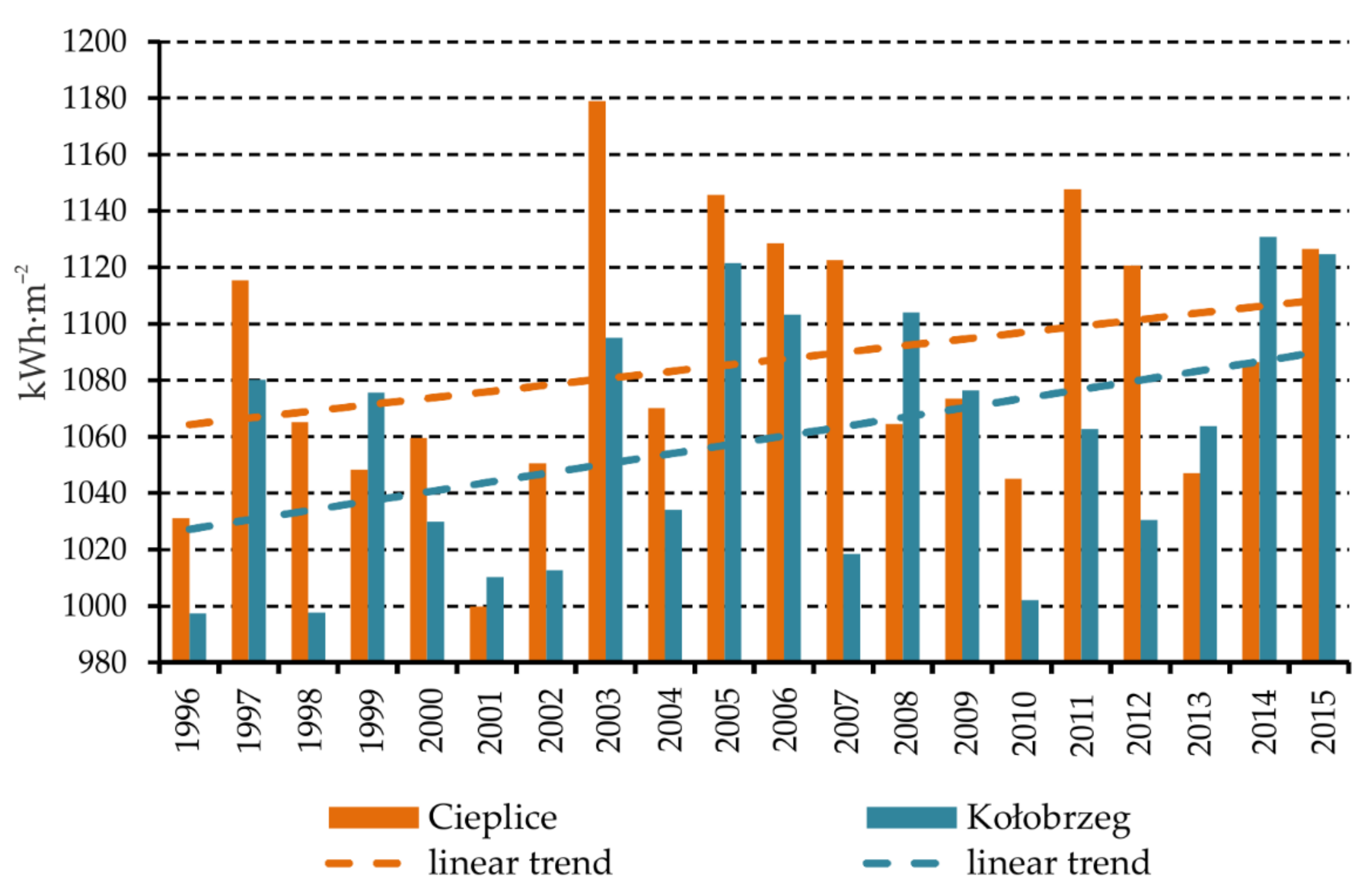
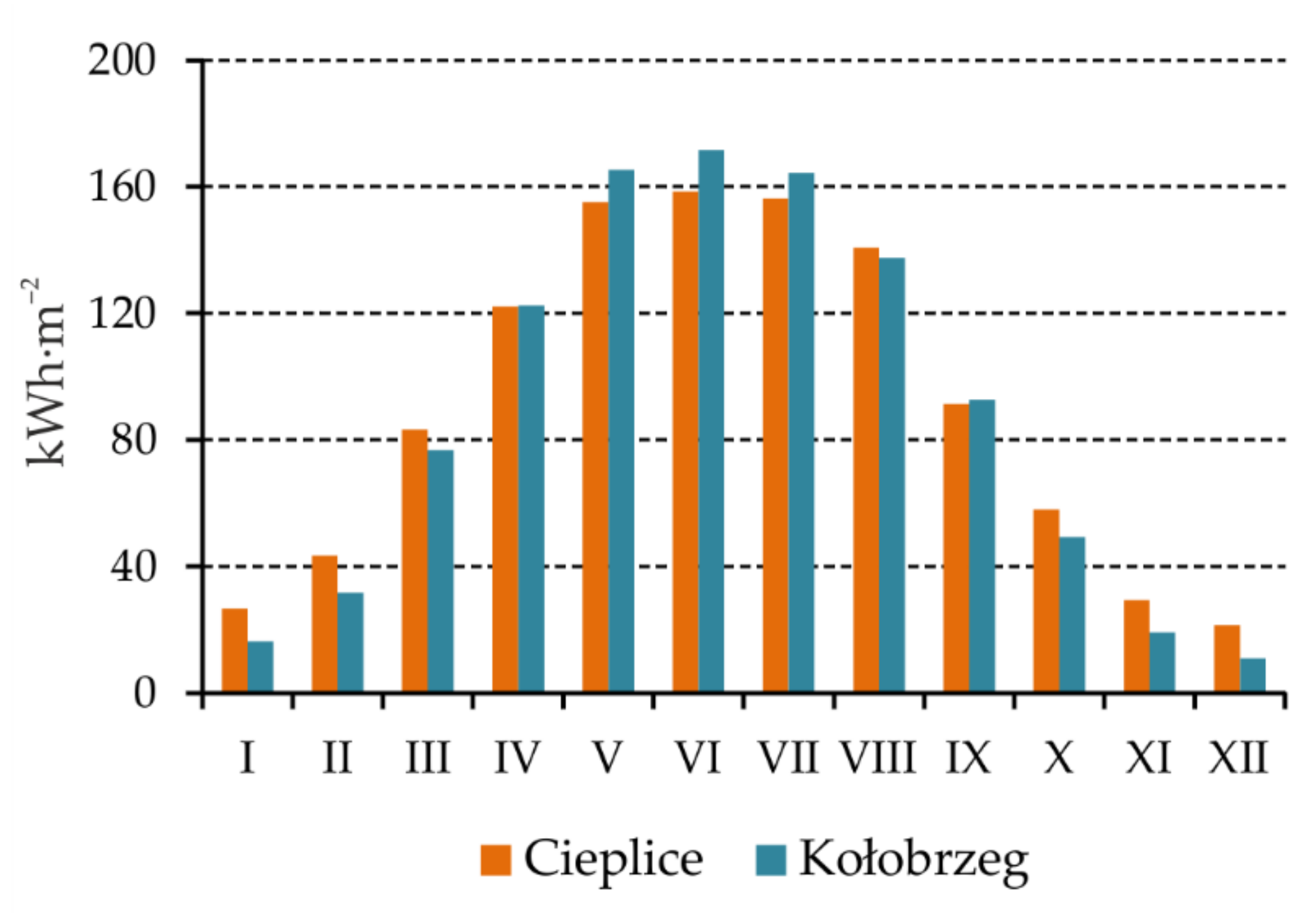

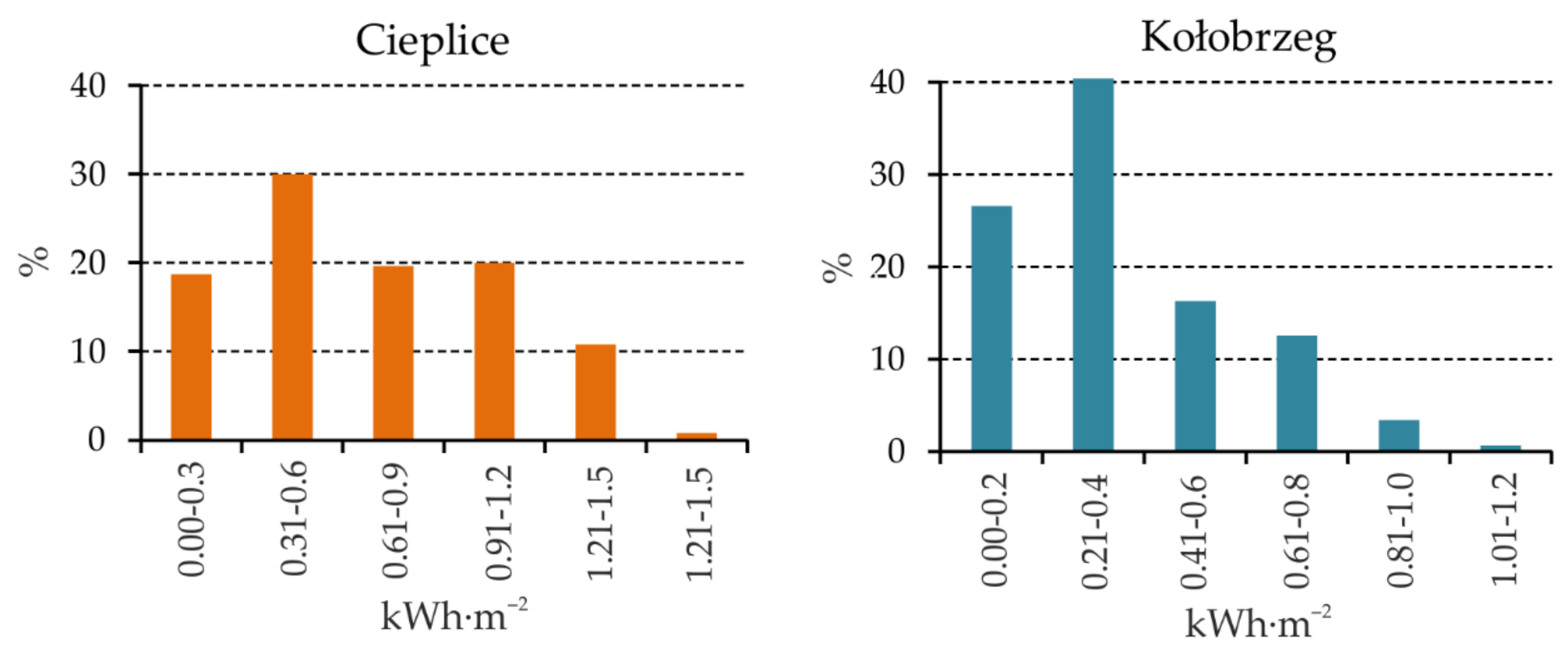


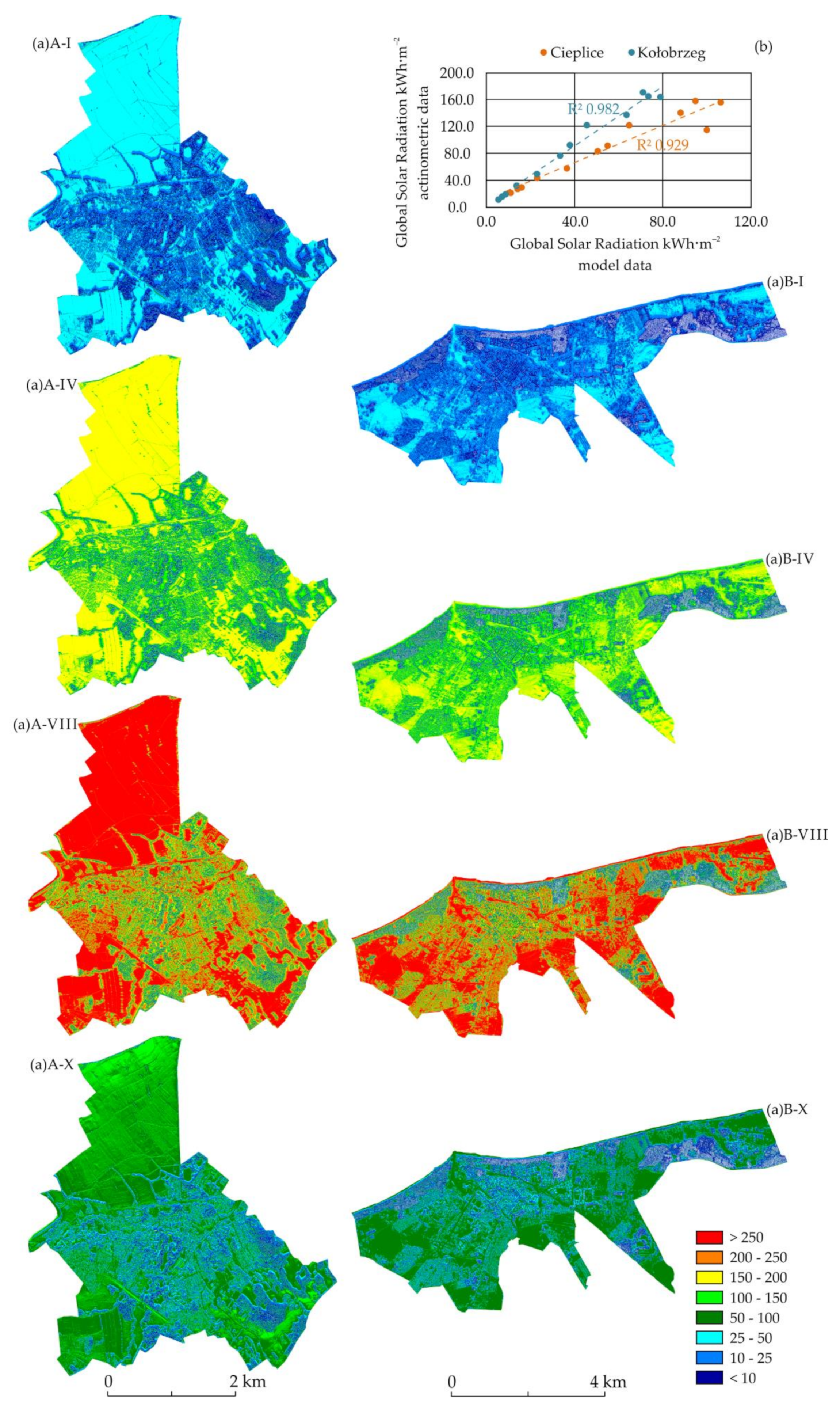
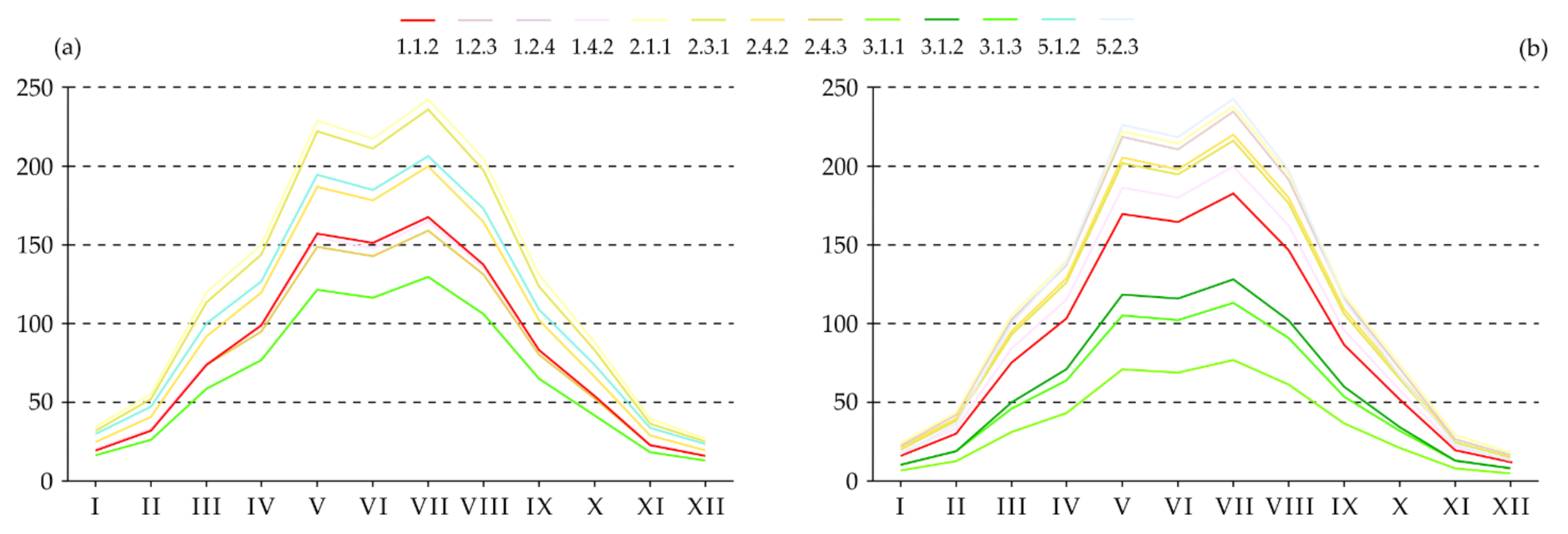
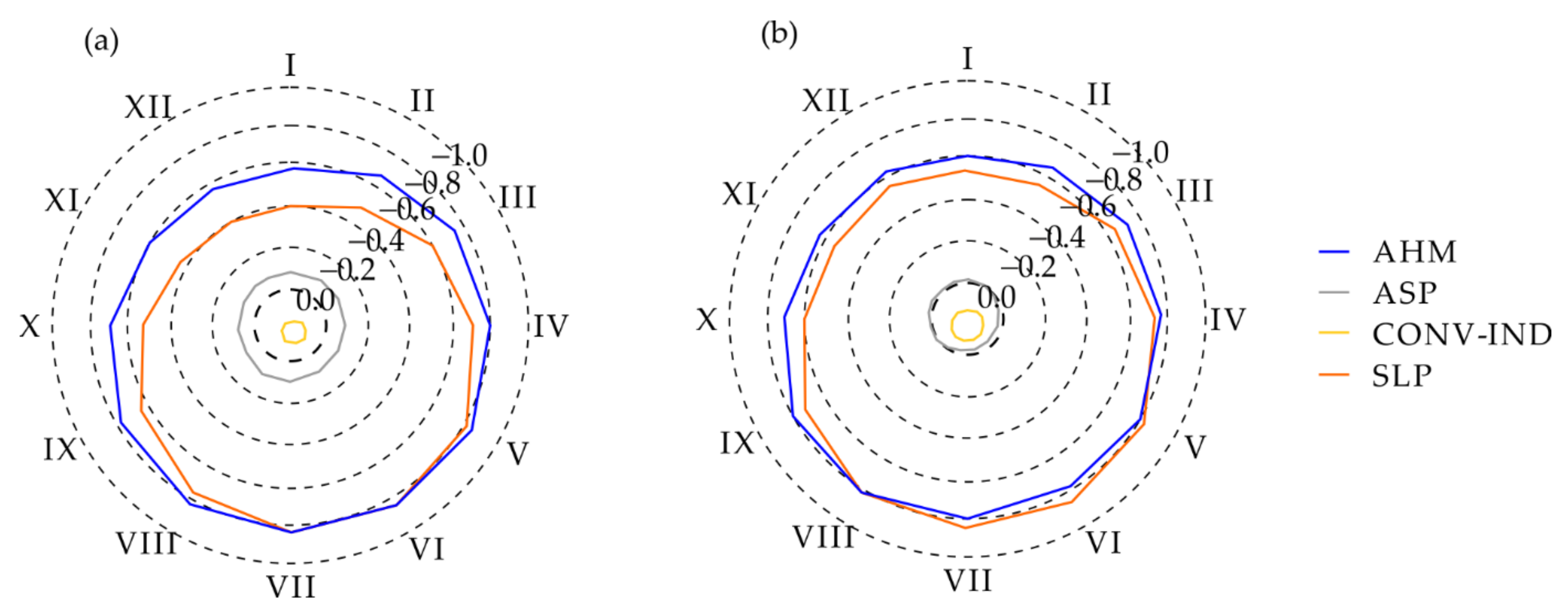
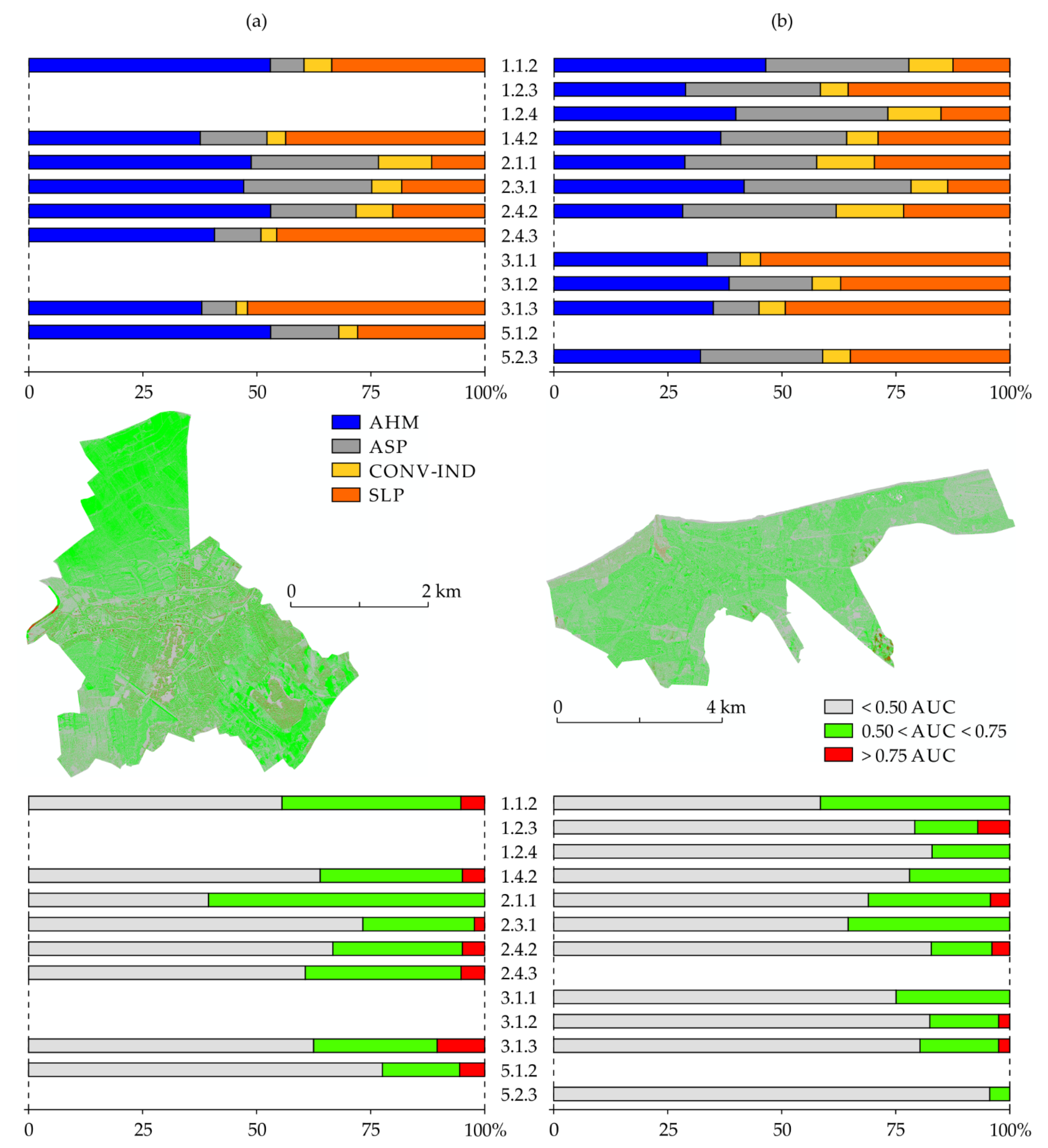
| No. | Predictor | Code | Unit | Mean | References |
|---|---|---|---|---|---|
| 1 | Analytical Hillshading max * | AHM | Rad | 0.781 | [78] |
| 2 | Aspect | ASP | Rad | 3.063 | [79] |
| 3 | Convergence Index | CONV-IND | - | −0.002 | [80] |
| 4 | Slope | SLP | Rad | 0.367 | [79] |
| Months | Sunless Period (Days) | Amount of Sunless Periods (>5 Days) | |||
|---|---|---|---|---|---|
| 5–7 | 8–10 | 11–13 | 14–16 | ||
| I | 2 | 2 | 0 | 0 | 4 |
| II | 5 | 0 | 0 | 0 | 5 |
| III | 2 | 0 | 0 | 0 | 2 |
| IV | 0 | 0 | 0 | 0 | 0 |
| V | 0 | 0 | 0 | 0 | 0 |
| VI | 0 | 0 | 0 | 0 | 0 |
| VII | 0 | 0 | 0 | 0 | 0 |
| VIII | 0 | 0 | 0 | 0 | 0 |
| IX | 0 | 0 | 0 | 0 | 0 |
| X | 2 | 0 | 0 | 0 | 2 |
| XI | 4 | 0 | 0 | 0 | 4 |
| XII | 11 | 0 | 0 | 0 | 11 |
| ∑ | 26 | 2 | 0 | 0 | 28 |
| Months | Sunless Period (Days) | Amount of Sunless Periods (>5 Days) | |||
|---|---|---|---|---|---|
| 5–7 | 8–10 | 11–13 | 14–16 | ||
| I | 10 | 4 | 1 | 0 | 15 |
| II | 7 | 3 | 0 | 0 | 10 |
| III | 1 | 0 | 0 | 0 | 1 |
| IV | 0 | 0 | 0 | 0 | 0 |
| V | 0 | 0 | 0 | 0 | 0 |
| VI | 0 | 0 | 0 | 0 | 0 |
| VII | 0 | 0 | 0 | 0 | 0 |
| VIII | 0 | 0 | 0 | 0 | 0 |
| IX | 0 | 0 | 0 | 0 | 0 |
| X | 3 | 0 | 0 | 0 | 3 |
| XI | 8 | 2 | 0 | 1 | 11 |
| XII | 16 | 3 | 1 | 0 | 20 |
| ∑ | 45 | 12 | 2 | 1 | 60 |
Publisher’s Note: MDPI stays neutral with regard to jurisdictional claims in published maps and institutional affiliations. |
© 2021 by the authors. Licensee MDPI, Basel, Switzerland. This article is an open access article distributed under the terms and conditions of the Creative Commons Attribution (CC BY) license (http://creativecommons.org/licenses/by/4.0/).
Share and Cite
Szatten, D.; Więcław, M. Solar Climate Features Taking into Account the Morphometric Conditions of the Area and the Possibility of Using Them in Heliotherapy on the Example of the Cieplice and Kołobrzeg Health Resorts (Poland). Atmosphere 2021, 12, 383. https://doi.org/10.3390/atmos12030383
Szatten D, Więcław M. Solar Climate Features Taking into Account the Morphometric Conditions of the Area and the Possibility of Using Them in Heliotherapy on the Example of the Cieplice and Kołobrzeg Health Resorts (Poland). Atmosphere. 2021; 12(3):383. https://doi.org/10.3390/atmos12030383
Chicago/Turabian StyleSzatten, Dawid, and Mirosław Więcław. 2021. "Solar Climate Features Taking into Account the Morphometric Conditions of the Area and the Possibility of Using Them in Heliotherapy on the Example of the Cieplice and Kołobrzeg Health Resorts (Poland)" Atmosphere 12, no. 3: 383. https://doi.org/10.3390/atmos12030383
APA StyleSzatten, D., & Więcław, M. (2021). Solar Climate Features Taking into Account the Morphometric Conditions of the Area and the Possibility of Using Them in Heliotherapy on the Example of the Cieplice and Kołobrzeg Health Resorts (Poland). Atmosphere, 12(3), 383. https://doi.org/10.3390/atmos12030383






